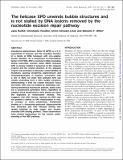Files in this item
The helicase XPD unwinds bubble structures and is not stalled by DNA lesions removed by the nucleotide excision repair pathway
Item metadata
| dc.contributor.author | Rudolf, Jana | |
| dc.contributor.author | Rouillon, Christophe | |
| dc.contributor.author | Schwarz-Linek, Ulrich | |
| dc.contributor.author | White, Malcolm F | |
| dc.date.accessioned | 2010-10-20T11:11:48Z | |
| dc.date.available | 2010-10-20T11:11:48Z | |
| dc.date.issued | 2010-01 | |
| dc.identifier | 1190481 | |
| dc.identifier | 733d990e-9348-4ea1-801a-264a95687cdb | |
| dc.identifier | 000274496900026 | |
| dc.identifier | 77950366206 | |
| dc.identifier.citation | Rudolf , J , Rouillon , C , Schwarz-Linek , U & White , M F 2010 , ' The helicase XPD unwinds bubble structures and is not stalled by DNA lesions removed by the nucleotide excision repair pathway ' , Nucleic Acids Research , vol. 38 , no. 3 , pp. 931-941 . https://doi.org/10.1093/nar/gkp1058 | en |
| dc.identifier.issn | 0305-1048 | |
| dc.identifier.other | ORCID: /0000-0003-1543-9342/work/47136128 | |
| dc.identifier.other | ORCID: /0000-0003-0526-223X/work/40714977 | |
| dc.identifier.uri | https://hdl.handle.net/10023/1048 | |
| dc.description.abstract | Xeroderma pigmentosum factor D (XPD) is a 5'-3' superfamily 2 helicase and the founding member of a family of DNA helicases with iron-sulphur cluster domains. As a component of transcription factor II H (TFIIH), XPD is involved in DNA unwinding during nucleotide excision repair (NER). Archaeal XPD is closely related in sequence to the eukaryal enzyme and the crystal structure of the archaeal enzyme has provided a molecular understanding of mutations causing xeroderma pigmentosum and trichothiodystrophy in humans. Consistent with a role in NER, we show that archaeal XPD can initiate unwinding from a DNA bubble structure, differentiating it from the related helicases FancJ and DinG. XPD was not stalled by substrates containing extrahelical fluorescein adducts, abasic sites nor a cyclobutane pyrimidine dimer, regardless of whether these modifications were placed on either the displaced or translocated strands. This suggests that DNA lesions repaired by NER may not present a barrier to XPD translocation in vivo, in contrast to some predictions. Preferential binding of a fluorescein-adducted oligonucleotide was observed, and XPD helicase activity was readily inhibited by both single- and double-stranded DNA binding proteins. These observations have several implications for the current understanding of the NER pathway. | |
| dc.format.extent | 11 | |
| dc.format.extent | 5401658 | |
| dc.language.iso | eng | |
| dc.relation.ispartof | Nucleic Acids Research | en |
| dc.subject | Replication protein-a | en |
| dc.subject | Escherichia-coli | en |
| dc.subject | Binding-protein | en |
| dc.subject | Saccharomyces-cerevisiae | en |
| dc.subject | Sulfolobus-solfataricus | en |
| dc.subject | Substrate-specificity | en |
| dc.subject | Breast-cancer | en |
| dc.subject | RAD3 Protein | en |
| dc.subject | Damage | en |
| dc.subject | Archaeal | en |
| dc.subject | QH426 Genetics | en |
| dc.subject | SDG 3 - Good Health and Well-being | en |
| dc.subject.lcc | QH426 | en |
| dc.title | The helicase XPD unwinds bubble structures and is not stalled by DNA lesions removed by the nucleotide excision repair pathway | en |
| dc.type | Journal article | en |
| dc.contributor.institution | University of St Andrews. School of Biology | en |
| dc.contributor.institution | University of St Andrews. Biomedical Sciences Research Complex | en |
| dc.identifier.doi | https://doi.org/10.1093/nar/gkp1058 | |
| dc.description.status | Peer reviewed | en |
| dc.identifier.url | http://www.scopus.com/inward/record.url?scp=77950366206&partnerID=8YFLogxK | en |
This item appears in the following Collection(s)
Items in the St Andrews Research Repository are protected by copyright, with all rights reserved, unless otherwise indicated.

